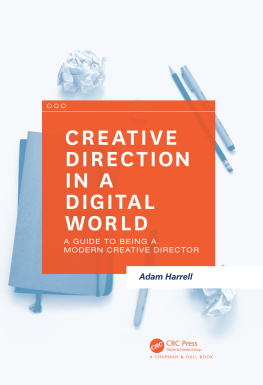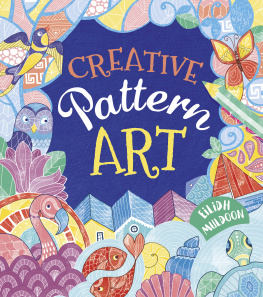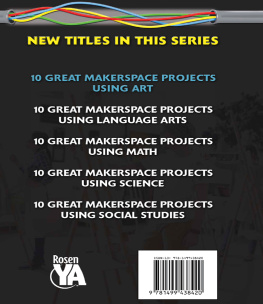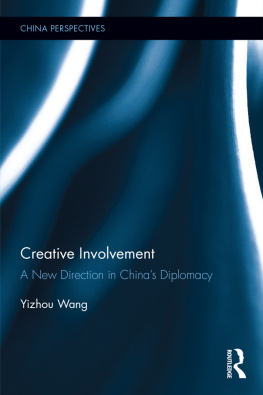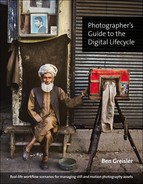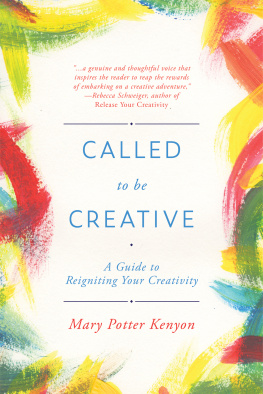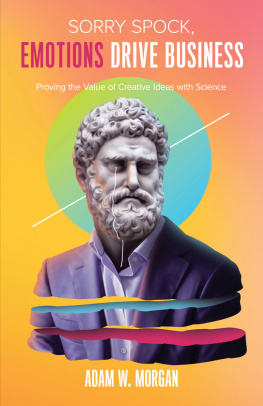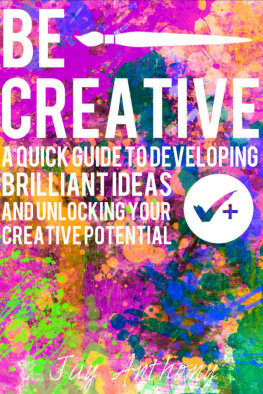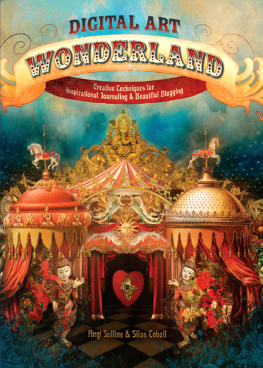Adam Harrell - Creative Direction in a Digital World: A Guide to Being a Modern Creative Director
Here you can read online Adam Harrell - Creative Direction in a Digital World: A Guide to Being a Modern Creative Director full text of the book (entire story) in english for free. Download pdf and epub, get meaning, cover and reviews about this ebook. year: 2016, publisher: CRC Press, genre: Romance novel. Description of the work, (preface) as well as reviews are available. Best literature library LitArk.com created for fans of good reading and offers a wide selection of genres:
Romance novel
Science fiction
Adventure
Detective
Science
History
Home and family
Prose
Art
Politics
Computer
Non-fiction
Religion
Business
Children
Humor
Choose a favorite category and find really read worthwhile books. Enjoy immersion in the world of imagination, feel the emotions of the characters or learn something new for yourself, make an fascinating discovery.
- Book:Creative Direction in a Digital World: A Guide to Being a Modern Creative Director
- Author:
- Publisher:CRC Press
- Genre:
- Year:2016
- Rating:5 / 5
- Favourites:Add to favourites
- Your mark:
- 100
- 1
- 2
- 3
- 4
- 5
Creative Direction in a Digital World: A Guide to Being a Modern Creative Director: summary, description and annotation
We offer to read an annotation, description, summary or preface (depends on what the author of the book "Creative Direction in a Digital World: A Guide to Being a Modern Creative Director" wrote himself). If you haven't found the necessary information about the book — write in the comments, we will try to find it.
Adam Harrell: author's other books
Who wrote Creative Direction in a Digital World: A Guide to Being a Modern Creative Director? Find out the surname, the name of the author of the book and a list of all author's works by series.
Creative Direction in a Digital World: A Guide to Being a Modern Creative Director — read online for free the complete book (whole text) full work
Below is the text of the book, divided by pages. System saving the place of the last page read, allows you to conveniently read the book "Creative Direction in a Digital World: A Guide to Being a Modern Creative Director" online for free, without having to search again every time where you left off. Put a bookmark, and you can go to the page where you finished reading at any time.
Font size:
Interval:
Bookmark:

There is nothing so terrible as activity without insight.
Johann Wolfgang von Goethe
Empathy is at the heart of creativity. If you can understand what others see, think, and feeltheir needs, wants, fears, and aspirationsthen you can design an experience that will connect with them.
Luckily human beings are born to be empathetic. Our brains actually have a special set of neurons called mirror neurons designed specifically for the task. They recognize the feelings of others and help us understand their intentions.
So if empathy is important and humans are good at it, then why is empathy often missing from creative work? The simplest explanation is that too often were designing experiences for ourselves. We get so caught up in the act of creating something that we forget who will actually be using it. We assume that everyone uses technology like we do and that we share a common worldview.
This is a dangerous habit. The best creative work is rooted in a deep understanding of the audience, but you can only gain this understanding if you seek it out.
In this chapter, well talk about the role that insights play in the creative process, the basic process of user research, and how findings can be shared via audience personas and buyer journey maps.
Insights can be found anywhere, but theyre always hidden. If they werent hard to find, they wouldnt be valuable. Your job is to root them out of their holes and drag them kicking and screaming into the light of day.
To find an insight, start by thinking about the customer and what they care about. Put yourself in their shoes. Imagine their livestheir hopes, their fears, and their worldview. Find the places they congregate and observe them carefully.
How would they describe themselves? What tribes do they belong to? How do they perceive the product or service? What are the pain points they have that the product or service solves? How would they describe it to a friend? What basic human desire are they trying to solve through their purchase? How considered is the purchase?
Start asking these questions, and listen carefully. Then start thinking about it and dont stop until youve found something meaningful.
By building empathy and finding insights you can make anything better, faster, smarter, easier, more usable, and more meaningful. It just takes effort to do so.
Theres no secret process to finding insights. Tenacity is the best advice I can give.
For instance, if youre building a campaign for a major sunglasses brand then you might start by asking a customer why they chose a specific brand. The answer would probably be rather rationalsomething like they were on sale.
This type of observation isnt very valuable. But, if you were to dig deeper and follow up each answer by asking them why, then something interesting happens. You start to get a deeper insight into how they view themselves and your product.
For example, Why did you buy them when you saw them on sale? Well, Ive always liked the look. Theyre a classic style. I like things that are timeless. Why is that important? Since it means theyre not going out of style. If Im spending $300 on a pair of sunglasses I want to be able to wear them for a long time.
Why is a powerful question that allows you to go beyond the initial answer and get to the root of the problem.
Sakichi Toyodathe founder of Toyota and the father of the Japanese Industrial Revolutionwas the first to document the power of asking why (Ohno 2006).
He cut his teeth building weaving devices and looms. When trying to perfect an automated loom, he actually conducted a yearlong experiment that had his looms running against his competitors in a real-world environment. As each of his looms failed he focused on how to improve their performance.
The methodology he used was simple. Like any good problem solver, he started by asking Why. But, he realized that you cant get to the root of the problem with a single question. A single question only identifies the symptom, not the root problem.
Like a child trying to figure out why the sky is blue, he repeated the question why? a minimum of five times in order to get to the root of the problem. This simple insight was the birth of what is known today as the 5 Whys method.
Why did the loom break? Because the gear jammed. Why did the gear jam? Because it ran out of oil. Why did it run out of oil? Because the operator didnt add it. Why does the operator need to add oil? Because oil isnt automatically added. Why isnt oil automatically added? Because there isnt an oil pump.
Sakichis method of root cause analysis is now taught in MBA programs around the world. But, his genius wasnt related to some magic insight. The 5 Whys method is applied common sense.
Its development was the result of his fierce tenacity in trying to get to the root of his problems. This same approach to problem solving applies to finding insights.
In 2001, one of the most hyped products of my lifetime was launched. TIME magazine ran a cover story entitled Reinventing the Wheel about a revolutionary new form of transport (Heilemann 2001). In fact, many said the company that made this revolutionary product would be the fastest company ever to reach $1 billion in sales. This product was the Segway.
The Segway, which is now seen as the transportation of choice for mall cops and city tours, is actually a pretty amazing piece of engineering. Its self-balancing, rechargeable, and easy to learn to use. In fact the inventor was so confident in his product he stated that the Segway will be to the car what the car was to the horse and buggy. It would usher in a whole new transportation revolution as cars would get banned from city roads and replaced with Segways.
So why didnt the Segway live up to the hype? How did it become the Ford Edsel of the dot com generation? The Segway is a great example of the danger of designing products based on a flawed understanding of the people who would actually use it. They were so concerned with being the first to bring their invention to market that they actually designed it in secret. They didnt seek feedback.
The result was a product that wasnt built for the real world. The Segway didnt protect the user in the rain. It was too big for crowded sidewalks and too small for roads. It was too heavy to store easily. People riding them looked a bit goofy.
If theyd been less concerned with secrecy and done proper audience research, they would have realized some of these flaws and could have iterated toward a solution. Instead they focused on raising money, building hype, and trying to invent the next great transportation revolution in isolation.
Years ago I was working with a major hotel group on a rebranding effort for one of their most successful brands. As part of this effort, they undertook a global research effort to guide their messaging and positioning.
They conducted a quantitative and qualitative research effort that spanned the globe. Focus groups, surveys, and every other form of market research technique was used during the project.
After hearing about this giant research effort, I was excited to see the results. After all, millions of dollars spent on research would definitely lead to some exciting insights.
So we gathered the teams in a conference room and the research findings were presented. Out of 100 plus slides, probably 30 had to do with how the research was conducted: descriptions of the techniques and maps of where it was conducted. The next 30 slides were pull quotes from interviews and survey result summaries.
Font size:
Interval:
Bookmark:
Similar books «Creative Direction in a Digital World: A Guide to Being a Modern Creative Director»
Look at similar books to Creative Direction in a Digital World: A Guide to Being a Modern Creative Director. We have selected literature similar in name and meaning in the hope of providing readers with more options to find new, interesting, not yet read works.
Discussion, reviews of the book Creative Direction in a Digital World: A Guide to Being a Modern Creative Director and just readers' own opinions. Leave your comments, write what you think about the work, its meaning or the main characters. Specify what exactly you liked and what you didn't like, and why you think so.

